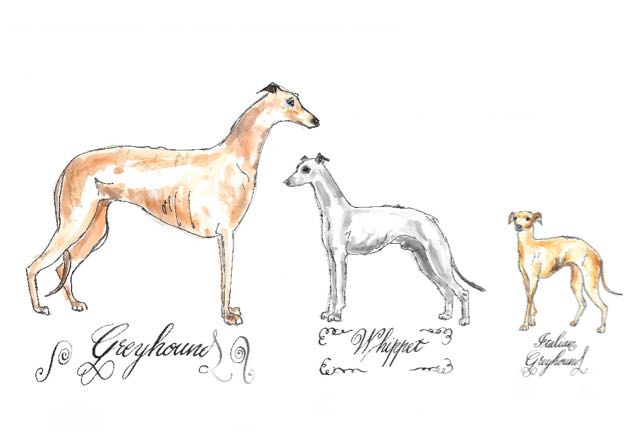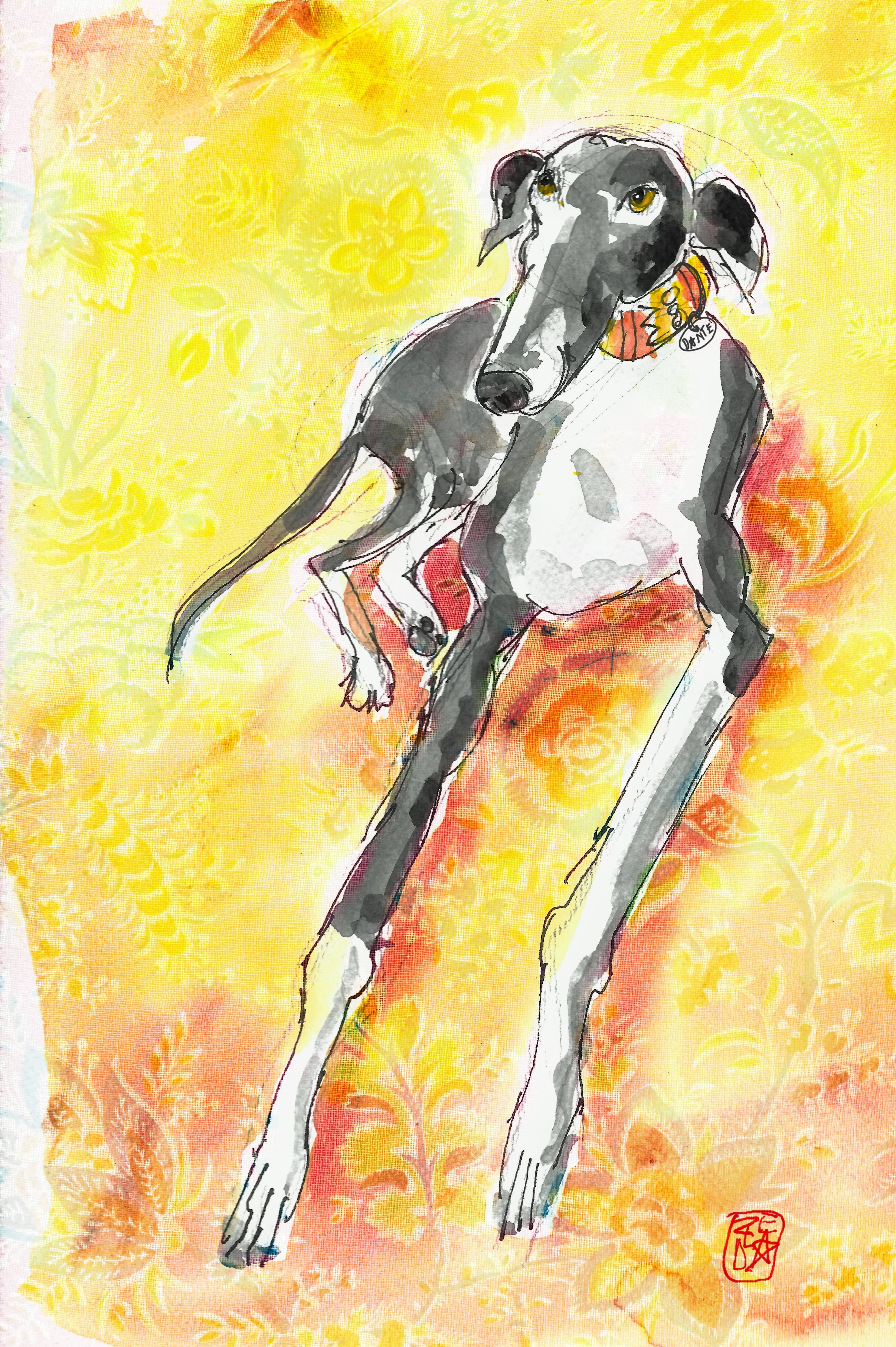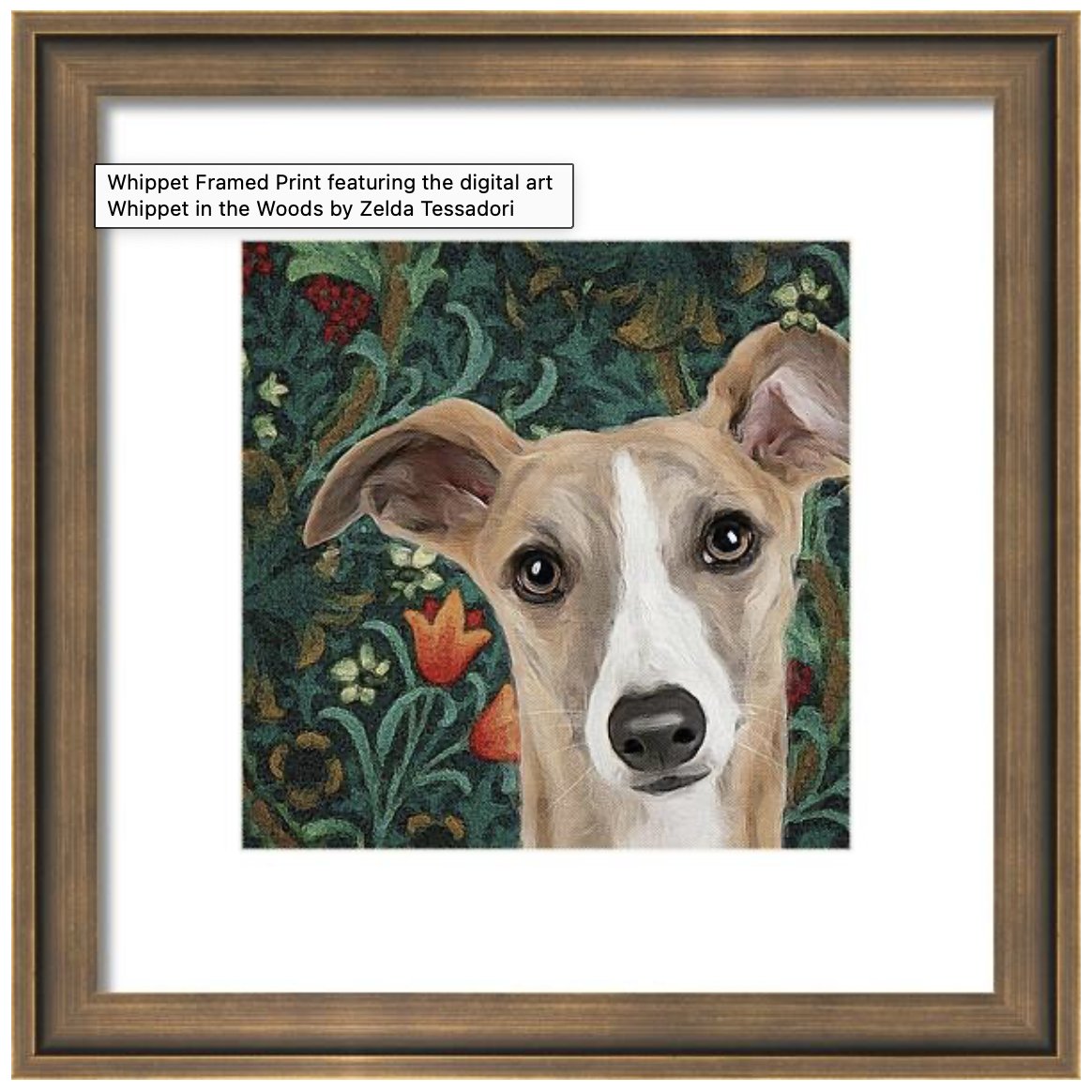Do you have a whippety question? Enter here your query or keyword.
- Home
- Whippet Info
- Difference Between Greyhound and Whippet
Difference Between Greyhound and Whippet
What’s the difference between greyhound and whippet? Find out which one is the right breed for you.
When it comes to choosing a dog breed, many potential owners find themselves considering the similarities and differences between various breeds.
Among the most frequently compared are the Greyhound and the Whippet, two sleek, fast, and elegant breeds that share a number of characteristics but also exhibit some notable differences. Whether you're drawn to their speed, athleticism, or gentle temperaments, understanding the differences and similarities between Greyhounds and Whippets can help you decide which breed is the right fit for your lifestyle.
Both whippet and greyhound are members of the same family of dogs, the sighthounds, fast canines that hunt independently by sight.
The mighty greyhound was favored by nobility and actually in Medieval England commoners were forbidden to own a greyhound to keep them off hunting in the royal hunting preserves.
Smaller greyhounds and cross breeds became the hunting companions of the lower classes, helping to keep at bay vermin and hunting for the pot more than amusement.
In the nineteenth century small greyhounds and mixed breeds became popular for betting sports like ratting and dog racing.
When rural workers moved to the cities they brought with them their little dogs that were more adaptable to the city life but could still be competitive in betting contests.
Main Difference Between Greyhound and Whippet: the Size
One of the primary differences between Greyhounds and Whippets is their size. While both breeds are considered sighthounds, the Greyhound is larger and more robust compared to the Whippet.
Greyhound Size and Weight
Greyhounds are large dogs, typically standing between 27 to 30 inches at the shoulder, with males generally being slightly taller than females. Their weight varies between 60 to 70 pounds, though it can be a bit higher for larger males. Greyhounds have long, muscular bodies, designed for high-speed running, and their frame is built to allow for efficient movement at full sprint.
Whippet Size and Weight
Whippets, on the other hand, are significantly smaller. They usually stand between 18 to 22 inches tall at the shoulder. Their weight ranges from 25 to 40 pounds, depending on the individual. Despite their smaller stature, Whippets still have the slender, athletic build typical of sighthounds and are renowned for their speed, though they are not as large or heavy as Greyhounds.
The difference between Greyhound and Whippet size is primarily a factor of the Greyhound’s larger, more muscular frame compared to the Whippet’s more compact build. Both breeds are agile and fast, but the Greyhound's size and strength make it better suited for longer races, whereas the Whippet excels in short bursts of speed.
When choosing between these breeds you must ask yourself if you can handle and lift, if necessary, a dog as heavy as a greyhound.
You must also consider that a big dog requires more general expenses, a larger quantity of food, a larger car, more space to exercise and more poop scooping willingness.
Below you can appreciate the size difference between a greyhound, a whippet and an Italian greyhound.

Body Proportions
While both breeds share the characteristic slender, aerodynamic body shape of sighthounds, the proportions of their bodies differ somewhat.
Greyhound Proportions
Greyhounds are longer and more elongated in their build. Their body is long, with a deep chest that allows for efficient lung capacity during racing. Their legs are long and muscular, built for running at high speeds over longer distances. Greyhounds have a narrow, graceful head and a deep, narrow chest, and their overall body structure reflects their role as long-distance sprinters.
Whippet Proportions
Whippets have a more compact body, with slightly less length in the torso compared to Greyhounds. While their overall body shape is similar, they are typically shorter in length and have a more balanced, square-like appearance. Their legs are also long and lean, but their chest is not as deep as the Greyhound’s, making them slightly less capable in longer races but still incredibly fast in short sprints.
This difference between Greyhound and Whippet body proportions contributes to the speed each breed excels at. Greyhounds are built for sustained running, whereas Whippets are specialized for high-speed bursts, making them fantastic at short-distance races and chase games.
Temperament and Attitudes
Both Greyhounds and Whippets are known for their gentle and affectionate natures, but their temperaments can vary somewhat.
Greyhound Temperament
Greyhounds are often described as gentle giants. Despite their large size, they tend to be calm and laid-back, especially once they have finished a run.
They are typically friendly and good with children and other pets, though they may have a high prey drive due to their history as hunting dogs.
Greyhounds are known for being quiet, often described as "couch potatoes" when indoors. They enjoy lounging but also appreciate short bursts of exercise. This breed is more likely to be independent and less needy than the Whippet.
Whippet Temperament
Whippets, while similarly gentle, tend to be a bit more energetic and playful.
They are known for being very affectionate with their families and enjoy spending time with people. Whippets are also friendly with other dogs, though they can be a bit more energetic and excitable compared to the typically reserved Greyhound.
This difference between Greyhound and Whippet temperaments can be attributed to the Whippet’s slightly more active and social nature, while Greyhounds are content to relax and enjoy the quiet life.
Whippets are very popular among sighthounds because they are the most obedient among a type of dogs that are well known for being very independent.
Puppy or Adult?
If you are considering to acquire an adult dog, you have better chances to find a grown up greyhound than a whippet.
Many greyhounds are retired racers, they are still young, already crate trained and can make wonderful pets.
Many organizations can help you find an adult greyhound to adopt while whippets generally start their lives as pets and are seldom given up for adoption.
Whippet do not run in professionally organized running contests so there are not retired whippet racers.
Origins and Historical Uses
The historical backgrounds of these two breeds reflect their shared ancestry but also highlight their distinct roles in the past.
Greyhound Origins and Uses
The Greyhound is one of the oldest dog breeds, with roots tracing back to ancient Egypt, where they were used for hunting due to their remarkable speed and keen eyesight.
Throughout history, Greyhounds have been used in coursing, where they would chase down game, particularly hares. The breed’s athleticism and speed were highly valued in hunting and racing.
Whippet Origins and Uses
Whippets have a more recent history, with their origins in 19th-century England. They were bred primarily for hunting small game and later became popular in dog racing.
Whippets are smaller and more agile than Greyhounds, making them excellent at chasing smaller animals and excelling in short-distance racing events. While they were also used for hunting, Whippets are more commonly associated with racing and companionship in modern times.
The difference between Greyhound and Whippet origins lies in their respective roles in hunting and racing, with the Greyhound having a more ancient and extensive history in both areas, while the Whippet became a specialized breed for short-distance racing and hunting small game.
Health
Both breeds are fairly healthy but the greyhound is, like most large breeds, more prone to gastric torsion or bloat.
Greyhounds may require some extra attention at feeding time like giving many smaller meals instead of a large one or moisten the food.
Some greyhounds are prone to hyperthyroidism that shows as bald thigh syndrome.
These dogs tend to lose hair on the outer thighs but this syndrome is more an aesthetic problem than a life threatening disease and can be treated with a hormone supplements.
Conclusion about Difference Between Greyhound and Whippet
Both Greyhounds and Whippets are incredible dogs, known for their grace, speed, and loyalty. While there are several similarities between these two breeds, such as their gentle temperaments, athletic builds, and history as sighthounds, there are also some notable differences. The difference between Greyhound and Whippet sizes, body proportions, temperaments, origins, and health concerns make each breed unique and suitable for different types of owners.
Ultimately, whether you’re drawn to the calm, laid-back nature of the Greyhound or the playful, affectionate personality of the Whippet, both breeds are wonderful companions. Understanding the difference between Greyhound and Whippet characteristics is the first step in finding the dog that best fits your lifestyle and preferences.
In conclusion both breeds make wonderful pets with, I would say, a little advantage to the whippet for his moderate size and obedient temperament.
On another hand if you are looking to rescue and adult dog, probably you’ll have an easier time finding a retired racing greyhound than a pet whippet given for adoption.




